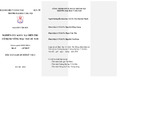
Vui lòng dùng định danh này để trích dẫn hoặc liên kết đến tài liệu này:
http://dulieuso.hmu.edu.vn/handle/hmu/2182| Nhan đề: | Nghiên cứu khúc xạ trên trẻ có bệnh võng mạc trẻ đẻ non |
| Tác giả: | Nguyễn Văn, Huy |
| Người hướng dẫn: | GS.TS. Tôn Thị Kim, Thanh |
| Từ khoá: | 62720157;Nhãn khoa |
| Tóm tắt: | THÔNG TIN TÓM TẮT NHỮNG KẾT LUẬN MỚI. CỦA LUẬN ÁN TIẾN SĨ. Những kết luận mới của luận án:. - Tỷ lệ tật khúc xạ trên trẻ mắc bệnh võng mạc trẻ đẻ non là 94,11%, trong đó cận thị chiếm tỷ lệ 66,57%, viễn thị 27,54%. Tỷ lệ cận thị cao ≥ 6D là 31,72% và tỷ lệ viễn thị cao 3D là 6,79%.. - Tỷ lệ loạn thị: 47,59%, trong đó 43,25% loạn thị cao >2D. Trục loạn thị: 88,2% loạn thị thuận, 3,93% loạn thị ngược và 7,87% loạn thị chéo.. - Tỷ lệ lệch khúc xạ: 23,98%.. - Số Diop trung bình của nghiên cứu: -2,81 ± 4,16D dao động từ -16,5D đến +5D.. - Tỷ lệ lác: 16,32% trong đó 56,25% lác trong và 45,75% lác ngoài.. - Cận thị, cận thị cao và mức độ cận thị có mối liên quan chặt chẽ với cân nặng và tuổi thai lúc sinh, bệnh điều trị hay không điều trị tự thoái triển và mức độ thoái triển của bệnh.. - Viễn thị cao và mức độ viễn thị không có mối liên quan có ý nghĩa thống kê với cân nặng và tuổi thai lúc sinh, bệnh điều trị hay không điều trị tự thoái triển và mức độ thoái triển của bệnh.. - Loạn thị có mối liên quan chặt chẽ với cân nặng và tuổi thai lúc sinh, bệnh điều trị hay không điều trị tự thoái triển và mức độ thoái triển của bệnh. Trong khi đó tỷ lệ loạn thị cao và mức độ loạn thị có liên quan với mức độ thoái triển của bệnh.. - Lệch khúc xạ không có mối liên quan có ý nghĩa thống kê với cân nặng và tuổi thai lúc sinh, nhưng có mối liên quan chặt chẽ với nhóm bệnh điều trị và không điều trị. Tỷ lệ lệch khúc xạ ở nhóm điều trị cao hơn có ý nghĩa thông kê so với nhóm không điều trị bệnh tự thoái triển.. SUMMARY THE NEW CONCLUSION OF THE THESIS. The new conclusions of the trial:. - The prevalence of refractive error in children with retinopathy of prematurity was 94.11% included 66,57% myopia and 27,54% hyperopia.. - The prevalence of high myopia ≥ 6D and high hyperopia ≥ 3D were 31.72%, 6.79% respectively.. - The prevalence of astigmatism was 47.59% and high astigmatism > 2D was 43.25%. Regarding to the axis of astigmatism; there were 88.2% with the rule, 3.93% against the rule and 7.87% oblique.. - The prevalence of anisometropia was 23.98%. - The prevalence of strabismus was 16.32% included 56.25% esotropia and 45.75 exotropia.. - The average spherical equivalent was -2.81± 4.16 (range: from -16.5D to + 5D). - The prevalence of myopia, high myopia and degree of myopia were concluded to besignificantly associated with 4 factors: 1) birth weight, 2) gestation age, 3) ROP either treated or regressed without treatment, 4) status of regressed ROP. In contrast, there were no significantly correlation between the prevalence of hyperopia, the degree of hyperopia and these 4 factors above.. - The prevalence of astigmatism was significantly associated with birth weight and gestation age and retinopathy of prematurity(ROP) either treated or regressed without treatment and status of regressed ROP. However, the prevalence of high astigmatism and degree astigmatism have significantly associated with status of regressed ROP.. - The prevalence of anisometropia was found no significantly associated with birth weight and gestation age. However, the prevalence of anisometropia was higher in eyes with treated ROP than in eyes with regressed ROP.. |
| Định danh: | http://dulieuso.hmu.edu.vn//handle/hmu/2182 |
| Bộ sưu tập: | Luận án (nghiên cứu sinh) |
Các tập tin trong tài liệu này:
| Tập tin | Mô tả | Kích thước | Định dạng | |
|---|---|---|---|---|
| 77_luan an - huy.pdf Tập tin giới hạn truy cập | 3.28 MB | Adobe PDF |  Đăng nhập để xem toàn văn | |
| 77_24 - Huy.pdf Tập tin giới hạn truy cập | 2.85 MB | Adobe PDF |  Đăng nhập để xem toàn văn |
Khi sử dụng các tài liệu trong Thư viện số phải tuân thủ Luật bản quyền.